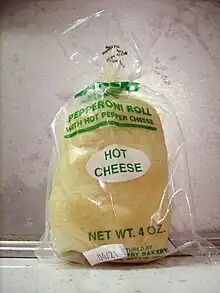Pepperoni roll
The pepperoni roll is an Italian-American stuffed bread roll. Originally conceived of as a coal miner's lunch, it is popular in West Virginia and some nearby regions of the Appalachian Mountains such as Eastern Kentucky, Western Pennsylvania, Western Maryland, and Appalachian Ohio.[1] In West Virginia it is nearly ubiquitous, particularly in convenience stores, and is arguably the food most closely associated with the state.[2] Pepperoni rolls are also found in Southeast Michigan where they were popular among auto workers in the factories.[3][4]
 | |
| Type | Bread |
|---|---|
| Place of origin | United States |
| Region or state | West Virginia |
| Main ingredients | White bread, pepperoni |
| Variations | cheese (usually mozzarella or provolone), marinara |
The classic pepperoni roll consists of a fairly soft white yeast-leavened bread roll with pepperoni baked in the middle. During baking, the fats in the pepperoni (which are hard at room temperature) melt, resulting in a spicy oil suffusing into the bread.[5] Pepperoni rolls are typically eaten for lunch or breakfast, either unheated or slightly warmed.[2]
Origins

The pepperoni roll was first sold by Giuseppe "Joseph" Argiro at the Country Club Bakery in Fairmont, West Virginia, in 1927.[6] The rolls originated as a lunch option for the coal miners of north-central West Virginia in the first half of the 20th century.[2][7] Pepperoni rolls do not need to be refrigerated for storage and could readily be packed for lunch by miners. Pepperoni and other Italian foods became popular in north-central West Virginia in the early 20th century, when the booming mines and railroads attracted many immigrants from Italy.[2] The pepperoni roll bears a resemblance to the pasty and sausage roll, which originated in the mining communities of Great Britain, as well as the Italian calzone.
Variations
Variations on the original pepperoni roll may contain different types of cheese, peppers, or other ingredients. The pepperoni within can take several forms, including a single stick, several folded slices, or shredded or ground meat.[8]
Legal challenges
In 1987, a bakery shipped pepperoni rolls from West Virginia to Maryland.[9] While the pepperoni had been inspected as an ingredient before it was baked into the rolls, the Food Inspection and Safety Service decided that the final product needed to be inspected as well because it was sold outside the bakery, similar to how a bakery making pepperoni pizzas would require inspection of the final product after the pizza was made.[9] The United States Department of Agriculture proposed reclassifying bakeries that manufactured the rolls as meat processing plants, thus subjecting them to daily inspections for hygiene.[9] The bakery owners said that meeting the new regulations would increase costs so much that producing pepperoni rolls would no longer be profitable to them. The United States Department of Agriculture suggested that the bakeries cut them in half and rename them pepperoni sandwiches, because cut sandwiches are not subject to the additional hygiene regulations, but the bakeries refused, saying customers would not buy pepperoni rolls cut in half.[9] Jay Rockefeller, U.S. Senator for West Virginia, intervened and met with Secretary of Agriculture Richard Lyng.[10] After the meeting, Secretary Lyng issued a special exemption to bakeries producing pepperoni rolls.[11]
As military rations
In the early 2000s, the U.S. military began including a version of the pepperoni roll in one of the MREs (Meals, Ready-to-Eat) provided to troops. In the late 2000s, the U.S. Army changed the pepperoni roll to its First Strike Ration. These rations are designed for light infantry, airborne, and special forces during a typical 72-hour patrol. The pepperoni roll's compact size and comparatively high nutritional return make it an ideal ration for these patrols. These rations were extensively employed during Operation Enduring Freedom. The military's rolls are made by a North Carolina company.[12]
See also
References
- "House passes bill declaring Pepperoni Roll official food of West Virginia". WDTV. 6 April 2021.
- John T. Edge (29 September 2009). "United Tastes - Pepperoni Rolls, a Piece of West Virginia Culinary History: Fast Food Even Before Fast Food". The New York Times. New York, NY. Style Section: Dining & Wine. Retrieved 3 November 2010.
- Michigan bakery ships special rolls to Shay Mikalonis’ family, Gary Dymski, Las Vegas Review-Journal, June 8, 2020
- Capri Italian Bakery founder had passion for baking and pepperoni roll, Susan Selasky, Detroit Free Press, June 17, 2019
- Heffner, Bob. "What is a Pepperoni Roll?". The Pepperoni Roll Homepage. Bob Heffner. Retrieved 1 December 2009.
- Mozier, Jeanne (April 1999). Way Out in West Virginia: A Must Have Guide to the Oddities & Wonders of the Mountain. Charleston, WV: Quarrier Press. ISBN 978-1-891852-02-2.
- "History of Pepperoni Rolls". Rogers & Mazzas Bakery / Marty's Italian Bakery. Archived from the original on 2 February 2009. Retrieved 2 December 2009.
- Heffner, Bob. "Pepperoni Roll Variations". The Pepperoni Roll Homepage. Bob Heffner. Retrieved 1 December 2009.
- "Food Safety Enforcers Keeping Hands Off the Pepperoni Rolls". The Washington Post. The Shreveport Journal (Shreveport, Louisiana). March 27, 1987. p. 8C.
- Rockefeller III, John D. (September 12, 2002). "Letter from Senator Rockefeller". Pepperoni Roll Rockefeller Letter. Bob Heffner. Retrieved November 3, 2010.
- "Ag Department Unwraps Red Tape Around Salami". The Associated Press. Iowa City Press-Citizen (Iowa City, Iowa). March 19, 1987. p. 1.
- Sullivan, Ken (2006). The West Virginia Encyclopedia. West Virginia Humanities Council. pp. 560–561. ISBN 0-9778498-0-5.
External links
- Restaurant Road Trip: Pepperoni Roll Competition from WBOY-TV
- Pepperoni rolls: W. Va. with an Italian accent Archived 2014-02-22 at the Wayback Machine from American Food Roots
- "The West Virginia Pepperoni Roll | West Virginia University Press". wvupressonline.com. 22 August 2016. Retrieved 2019-03-20.